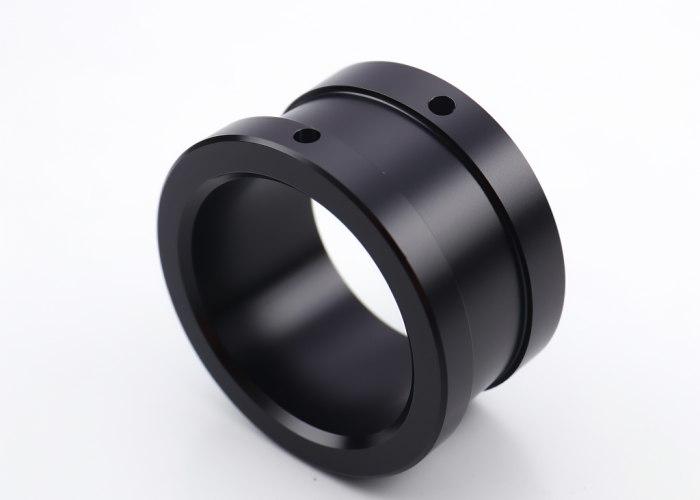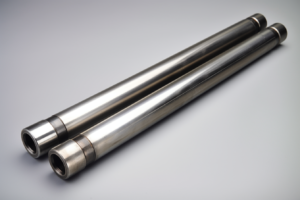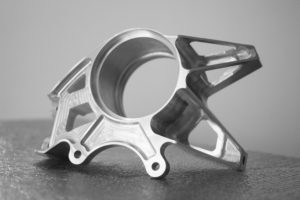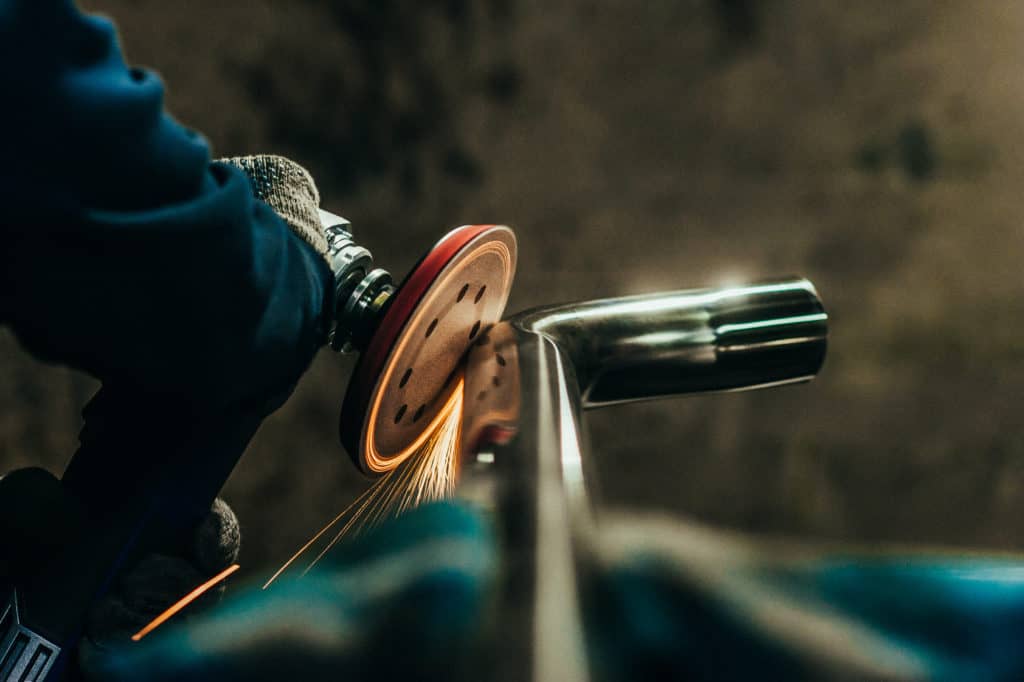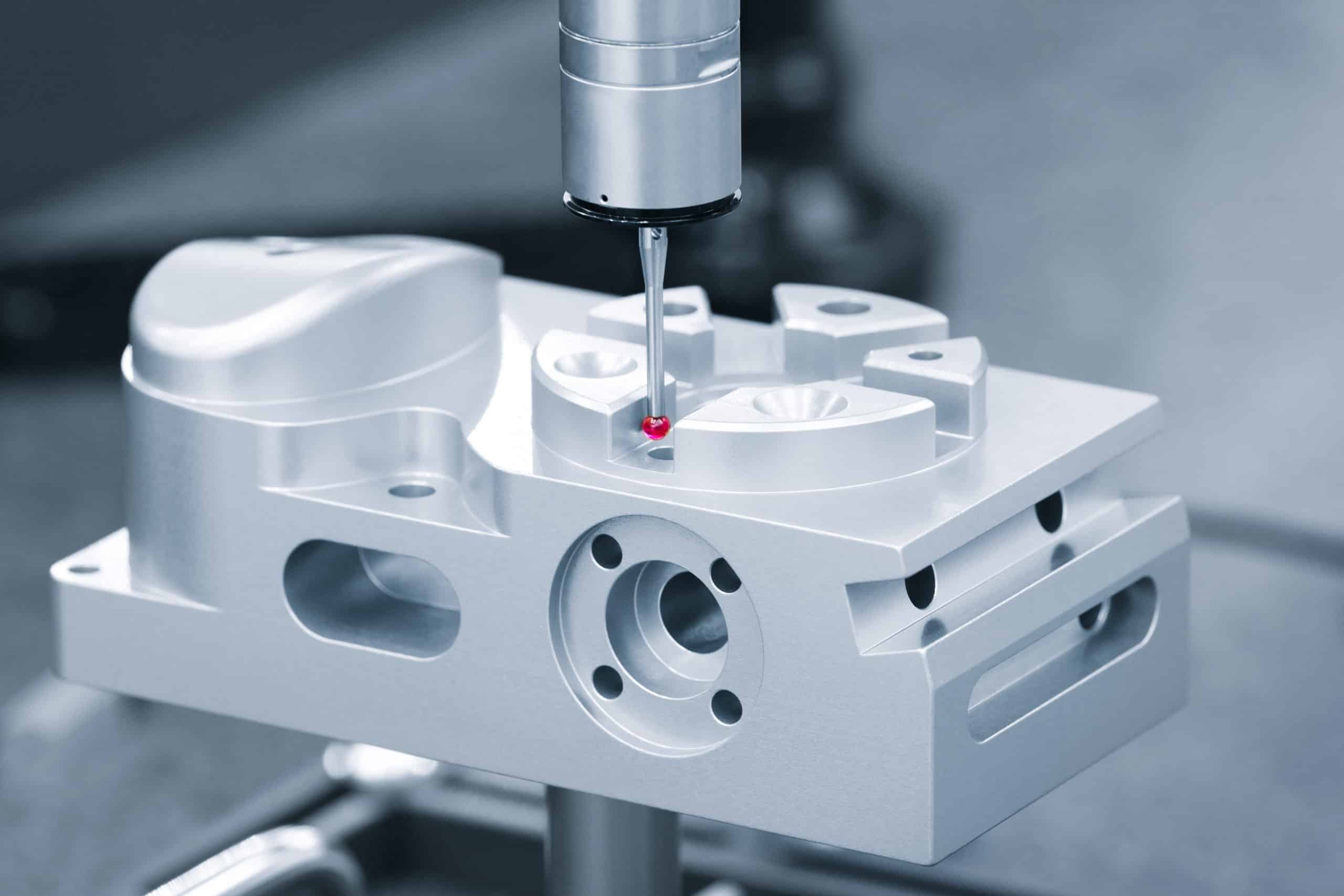Choosing black anodizing for aluminum parts affects both appearance and function. With experience finishing thousands of components across aerospace, audio, and medical applications, small specification details make a big difference in cost and performance.
Black anodizing creates a durable oxide layer that adds 0.0005-0.002″ per side to aluminum parts. It provides excellent corrosion and wear resistance while delivering an attractive matte black finish, though it reduces electrical conductivity.
Learn how anodizing thickness affects tolerances, when to choose Type II vs Type III, and design considerations that prevent costly assembly issues.
Table of Contents
Does black anodizing change aluminum part dimensions and tolerances?
Yes, black anodizing adds 0.0005-0.002″ (0.013-0.051 mm) per surface, which can cause interference fits or assembly issues if not accounted for during design. Type II anodizing typically adds 0.0007″ per side, while Type III hardcoat can add up to 0.002″ per side.
In our experience with audio faceplates and medical enclosures, designers often overlook anodizing buildup on mating surfaces. A 0.500″ diameter shaft with ±0.002″ tolerance becomes 0.501-0.504″ after Type II anodizing, potentially interfering with bearings sized for base aluminum dimensions. For parts with ±0.001″ tolerances, anodizing thickness variation can consume 50-100% of your tolerance band.
The impact depends on your application: press-fits and threaded holes need careful planning, while general enclosures with >0.010″ clearances rarely have issues. We measure parts before and after anodizing to verify actual buildup, which varies based on alloy and processing parameters. Per ISO 7599 standards, thickness tolerances are ±25% of specified coating thickness.
Feature Planning Guide:
- Press fits: Size for post-anodizing dimensions
- Threaded holes: Mask or tap after anodizing
- Sliding surfaces: Add 0.002″ minimum clearance
- Tight tolerances: Consider ±0.002″ on non-critical features
Design Takeaway: Specify critical dimensions as “after anodizing” on drawings and mask areas where dimensional control outweighs surface protection benefits.
Does black anodizing provide corrosion and wear protection?
Yes, black anodizing significantly improves corrosion resistance and wear protection compared to bare aluminum. Type II anodizing provides moderate protection suitable for indoor applications, while Type III hardcoat offers superior durability for outdoor use and high-wear environments. The anodized layer provides excellent resistance to salt spray, UV exposure, and abrasion.
Application Guide:
- Handheld devices: Type II sufficient for normal handling
- Sliding mechanisms: Type III prevents wear-through
- Marine/outdoor: Type III + sealing for harsh environments
- High-impact areas: Consider radius corners or protective design
We’ve tested anodized parts across demanding applications from marine audio equipment to outdoor instrumentation housings. Standard Type II black anodizing typically withstands 336+ hours of salt spray testing per ASTM B117, making it suitable for handheld devices and control panels with normal use. Type III hardcoat can exceed 1000+ hours of salt spray testing and prevents wear-through on sliding mechanisms or frequent-contact surfaces.
Both types maintain integrity up to 320°F (160°C), though the anodized coating begins to crack above this temperature due to thermal expansion differences between aluminum and aluminum oxide. Sharp impacts can chip anodizing at edges, and scratches appear as bright aluminum lines through the black coating. When this happens, touch-up options are limited since anodizing can’t be spot-repaired.
Design Takeaway: Choose Type II for indoor applications and aesthetic protection, Type III for outdoor use or high-wear environments. Design with edge protection in mind since coating damage typically occurs at corners and contact points.

How consistent is black anodizing color across multiple parts?
Black anodizing color consistency depends on alloy type, processing parameters, and batch size, with variation between batches similar to what you’d see in automotive trim pieces. Parts from the same anodizing batch generally match well, but color can vary noticeably between different production runs – particularly under fluorescent lighting. 6061 aluminum provides the most consistent black color, while 7075 and 2024 alloys may show variations due to copper content.
From our production experience with instrumentation housings and precision enclosures, color matching matters most for visible assemblies where multiple parts sit adjacent to each other. We’ve found that anodizing all related parts in the same batch produces excellent color consistency. When parts must be anodized separately, slight variations are typically acceptable under normal lighting but may be noticeable in direct comparison.
The variation occurs because rack position in the anodizing tank, current density, temperature, and dye concentration all influence final appearance. For critical assemblies, we recommend ordering 10-20% extra parts from the same batch for future repairs or replacements. Waiting for color matching between batches typically adds 5-7 days to delivery.
Design Takeaway: For critical color matching, anodize all visible parts together and specify 6061 alloy when possible. Consider ordering spare parts from the same batch for future service needs, and specify acceptable color tolerance requirements upfront.
Is black anodized aluminum electrically conductive?
No, black anodizing creates an electrical insulator that blocks conductivity between aluminum and external contacts. The aluminum oxide layer provides dielectric strength of 1000-2000 volts depending on thickness, while standard anodizing films break down at about 600 volts. This makes anodized parts unsuitable for applications requiring electrical grounding, EMI shielding, or conductivity-critical connections without design modifications.
In our experience with electronic enclosures and grounding applications, designers often overlook this limitation when specifying anodized parts. The oxide layer completely isolates the underlying aluminum from electrical contact, which creates problems in assemblies requiring chassis grounding or EMI continuity. We’ve seen projects require costly redesigns when anodized enclosures couldn’t provide proper RF shielding effectiveness or grounding paths through the coating.
However, this insulating property benefits electrical isolation applications where components must be electrically separated while maintaining mechanical contact. For applications requiring both anodizing and electrical contact, effective solutions include masking grounding areas during processing, which adds cost but preserves conductivity. Alternatively, threaded holes can be tapped after anodizing to remove coating, or conductive hardware like star washers can create grounding paths through the coating. EMI gaskets must contact bare aluminum areas for effectiveness since the anodized surface provides excellent electrical isolation.
Design Takeaway: Plan electrical continuity early in design phases. Specify bare aluminum zones on drawings for grounding or EMI contact points since anodized surfaces require workarounds that add cost and complexity to assemblies requiring electrical conductivity.
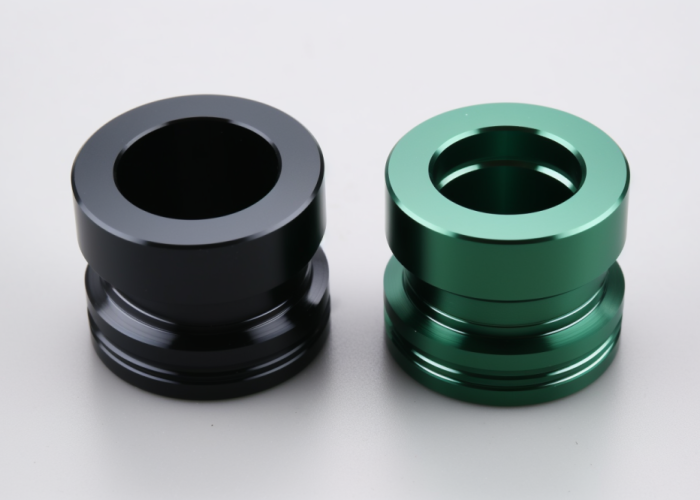
How durable is black anodizing against scratching and fading?
Black anodizing offers good scratch resistance for normal handling but shows permanent damage from sharp impacts or abrasive contact. Type II provides moderate protection suitable for equipment with occasional contact, while Type III hardcoat can achieve microhardness greater than HV 400 with friction coefficients below 0.4. However, scratches appear as bright aluminum lines through the black coating and cannot be repaired.
From our production experience with audio equipment and handheld devices, anodized surfaces handle normal use well – defined as occasional finger contact, light cleaning, and indoor environments. Type II shows visible scratches after extended handling, while optimized anodizing processes can achieve wear rates as low as 2.12 × 10⁻⁷ g/N.m in abrasion testing. The black color itself provides excellent UV stability with minimal fading after years of direct sunlight exposure, significantly outperforming painted finishes.
Surface scratching affects appearance but not function, while coating breakthrough exposes the underlying aluminum substrate and compromises corrosion protection. Sealing decreases the wear resistance of oxide film formed by hard anodizing up to 50-70% of the unsealed value. Sharp edges and corners are most vulnerable since the brittle oxide layer chips under impact loads, making design considerations important for high-contact applications.
For cleaning and maintenance, use soft cloths and mild soap while avoiding abrasive cleaners that can damage the surface. Type II anodizing provides adequate protection for aesthetic applications with light contact, while Type III hardcoat maintains appearance longer in high-wear environments and offers superior resistance to sliding contact.
Design Takeaway: Use Type II for aesthetic applications with light contact, Type III for high-wear environments. Design with rounded edges and specify Type III for any surfaces subject to sliding contact or frequent handling to maximize durability and appearance retention.
When should you avoid black anodizing for aluminum parts?
Avoid black anodizing when electrical grounding, very tight tolerances, or frequent disassembly are required. The insulating oxide layer blocks electrical contact, adds thickness that can interfere with precision fits, and creates permanent changes that can’t be easily reversed. Alternative finishes like powder coating or chemical conversion may better serve these applications.
In our experience with electronic assemblies and precision components, several scenarios make anodizing problematic. Parts requiring electrical grounding or EMI shielding lose conductivity since the anodized surface acts as an insulator. Precision bearing fits and threaded assemblies can experience interference problems when anodizing thickness affects critical dimensions. Medical devices needing FDA food-contact compliance face regulatory hurdles since anodizing may not meet requirements.
Cost and timing considerations favor alternatives for smaller runs. Production quantities under 100 pieces often make powder coating more economical due to anodizing’s $75-125 minimum batch charges. Lead times of 6-7 days for anodizing versus 3-5 days for powder coating can impact tight project schedules. Parts requiring frequent maintenance suffer since anodized threads can gall during disassembly, and damaged coating cannot be spot-repaired.
Technical limitations include exposure to strong cleaning chemicals or temperatures above 300°F, which cause coating degradation. Parts requiring post-finishing machining lose protection where material is removed.
Quick Decision Guide:
- Avoid when: Quantities <100 pieces, electrical contact needed, tolerances <±0.001″
- Choose alternatives for: Food contact, frequent disassembly, harsh chemical exposure
Design Takeaway: Choose alternatives when electrical contact, dimensional precision, regulatory compliance, or serviceability outweigh anodizing’s corrosion and aesthetic benefits.
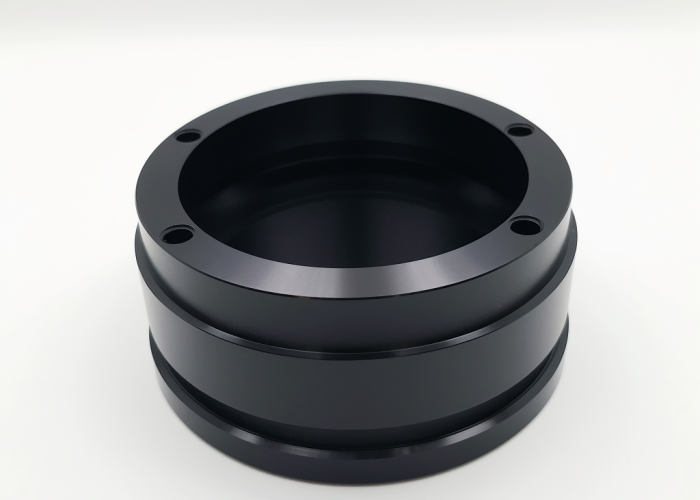
What's the difference between Type II and Type III black anodizing?
Type II creates a thin decorative coating perfect for indoor applications, while Type III produces a thick hardcoat built for demanding environments. Type II uses standard processing and works well for electronic enclosures and control panels. Type III requires specialized processing and costs more, but provides superior wear resistance for high-contact applications.
From our production experience, clear application thresholds guide the selection. Type II works excellently for electronic housings, control panels, and aesthetic components with occasional contact – think handheld devices used a few times daily. It accepts dyes easily, provides consistent black coloration, and handles normal indoor use well. Processing takes 6-7 days with competitive pricing for volume orders.
Type III hardcoat excels for sliding mechanisms, bearing surfaces, and components subject to frequent handling – parts contacted hundreds of times daily or exposed to outdoor environments. The thicker coating provides significantly better wear resistance and maintains appearance 3-5 times longer under heavy use. However, it costs 50-100% more due to specialized processing and extends lead times to 7-10 days.
Color consistency differs between types. Type II readily accepts dyes for uniform black finishes, while Type III appears quite dark even without dye. Type II shows visible wear after 6-12 months of heavy contact, while Type III maintains appearance for 2-3 years under similar conditions.
Selection Guide:
- Type II when: Occasional contact, indoor use, cost-sensitive projects
- Type III when: Daily heavy contact, outdoor exposure, maximum durability needed
Design Takeaway: Choose Type II for aesthetic and moderate-duty applications. Upgrade to Type III when heavy wear or harsh environments justify the 50-100% cost premium and longer lead times.
Conclusion
Black anodizing provides excellent corrosion protection and aesthetic appeal for aluminum parts, but requires careful consideration of dimensional tolerances, electrical requirements, and application-specific performance needs. Choose Type II for decorative applications, Type III for high-wear environments. Contact us to explore manufacturing solutions tailored to your black anodized aluminum requirements.
Frequently Asked Questions
Most anodizers have minimum batch charges of $65-125 rather than strict piece quantities, with cost-effective batches starting at 25-100 pieces depending on part size. This typically covers 100-150 small parts for basic Type II processing. Orders below these quantities often favor alternative finishes like powder coating due to better economics.
Yes, but machining after anodizing removes the protective coating in those areas, exposing bare aluminum that’s susceptible to corrosion. It’s better to mask critical features during anodizing or tap threads before the anodizing process. Post-anodizing machining should be avoided unless absolutely necessary for dimensional requirements.
Black anodizing typically has minimum batch charges of $65-125, with cost-effective quantities starting at 25-100 pieces depending on size. Lead times are 6-7 business days for Type II and 7-10 days for Type III. Bulk orders can reduce per-part costs significantly, with some providers offering pricing as low as $0.25 per part in bulk quantities. Rush orders typically increase costs by 50-75%.
Black anodizing will not hide machining marks or surface imperfections – it follows the existing surface contours exactly. Tool marks, scratches, or rough finishes will remain visible through the coating. For best appearance, parts should be finished to the desired surface quality before anodizing, often requiring bead blasting or polishing to achieve smooth surfaces.
No, anodized coatings cannot be spot-repaired or touched up once damaged. Scratches, chips, or worn areas expose the underlying aluminum permanently. The only repair option is complete strip and re-anodizing, which is usually more expensive than replacement. Design parts with damage-prone areas in mind and consider protective measures.
Yes, anodizing adds thickness that can affect thread fit and converts mating surfaces from aluminum-on-aluminum to ceramic-on-ceramic contact, which increases friction and galling tendency. Fine threads may become tight or non-functional, and anodized threads are more prone to galling during assembly. Consider masking threaded areas or using anti-seize compounds during assembly to prevent seizing.
